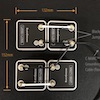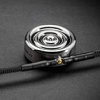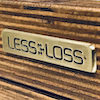
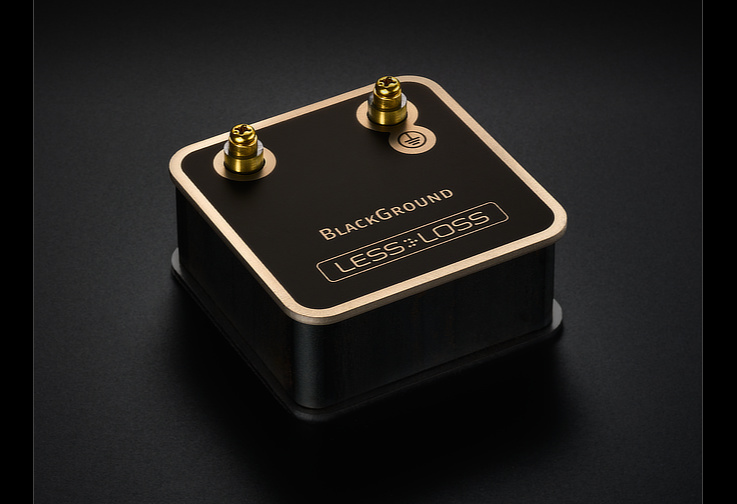 Blackground is an innovative new technology developed by LessLoss which comes in simple modular form. One such device connects any tapped AC or DC voltage to ground. This special connection elevates sonic performance to unprecedented levels. Any signal can be used, including line level signals, speaker signals with high current, or even power voltages. No current flows through between the Blackground's two contact terminals. For size information, click on the photo gallery thumbnails above. For usage instructions, see the following descriptions. If you want a ready-made, plug-and-play solution for power, click here to go to the BlackGround 10x Power Base page. Blackground can be used in a variety of ways to elevate sonic performance. Below, you can see how to incorporate it in different applications. Blackground will not colour or skew the sound in any direction. Instead, with each additional Blackground interface, the sonic results will become more and more transparent, insightful, rich in expression, and more easily comprehensible in focus and clarity. If you find yourself turning up the volume, that is the ultimate sign of progress, for if you test acoustically using a loudness meter, you will see that nothing has changed in terms of SPL. Sonic purity simply begs the listener for higher levels because of the aural attractiveness of newly revealed substantive detail. Below, we divide the Blackground instructions into separate categories. Click each to jump to the corresponding section for details. 1-- General rule for all applications; performance-scaling 2-- Specific use for loudspeaker audio signals 3-- Specific use for unbalanced line level (RCA) audio signals 4-- Specific use for balanced line level (XLR) audio signals 5-- Specific use for AC power voltages 6-- Specific and unique use for the LessLoss Blackbody v.2 1--General rule for all applications and tips for performance scalingFor any signal, regardless of whether it is AC, DC, low voltage or high voltage up to 250V, one taps the ‘send’ voltage between power source and load and introduces this voltage unto the Blackground's contact post without marking. For DC applications, this is the positive voltage line. For AC applications, this is the phase positive line.Likewise, for the load's ‘return’ signal, one taps the ‘return’ voltage between the load and power source. For DC applications, this is the negative voltage which returns to the power source. For AC applications, this is the phase negative line. Both Blackground devices connect to a mutual ground plane which represents the ground potential of the earth. If single-polarity Firewall It is of no consequence exactly where along the lines the voltages for the Blackground are tapped. This can be at the source end or at the load end of the line. This can also be before the single-polarity Firewalls or after them. 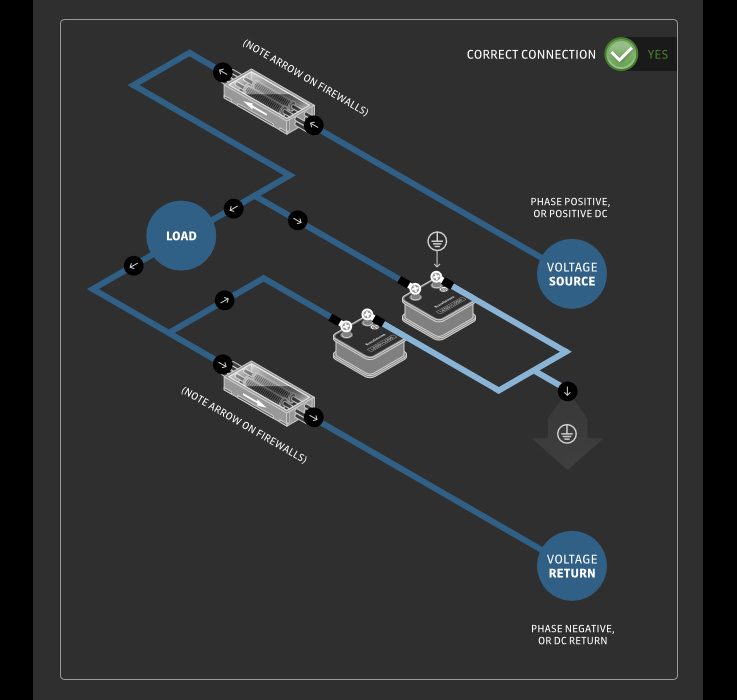
To scale up performance, the number of Blackground interfaces can be doubled per line. Connect in the following way:
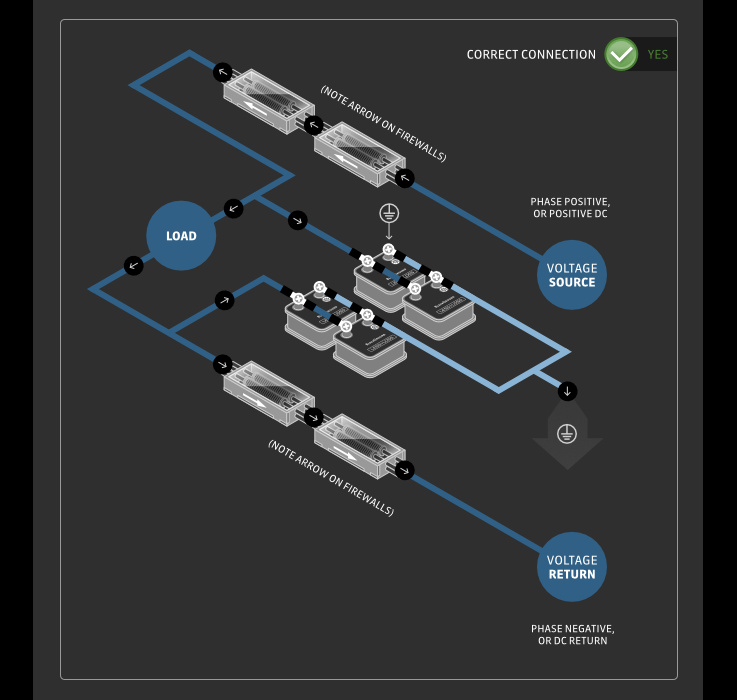
To further scale up performance, add the same number of Blackground interfaces to both send and return lines. Add them in the following way:
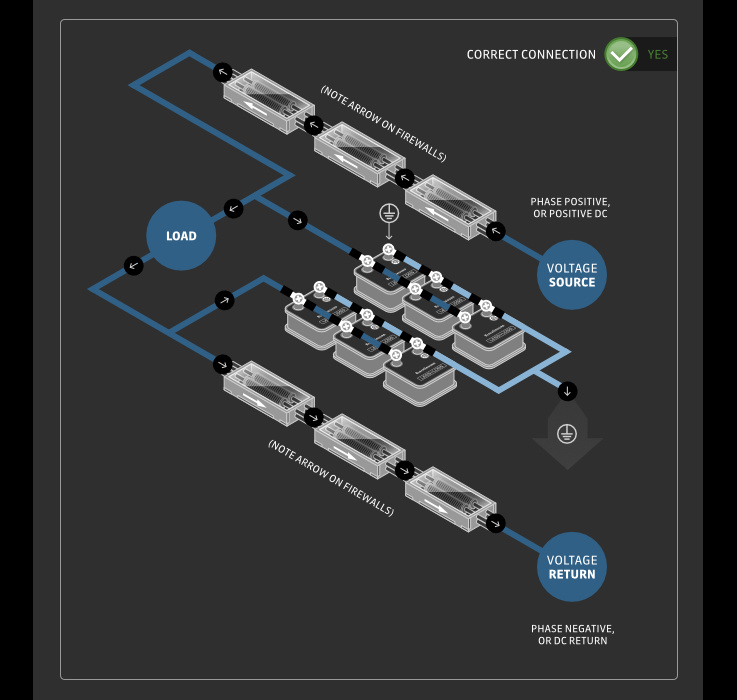
There is no known limit to the number of Blackground devices in use before the onset of diminishing returns. It is, however, recommended that before intense scaling, the available number of units should ideally be spread out between applications: on power supply voltages, on loudspeaker signals, online level signals and on Blackbody grounding lines. Concentrating many such modules on only one application will probably not lead to the most efficient results.
The modular nature of this product allows one to easily add to or change any number of units in an application any time in the future. 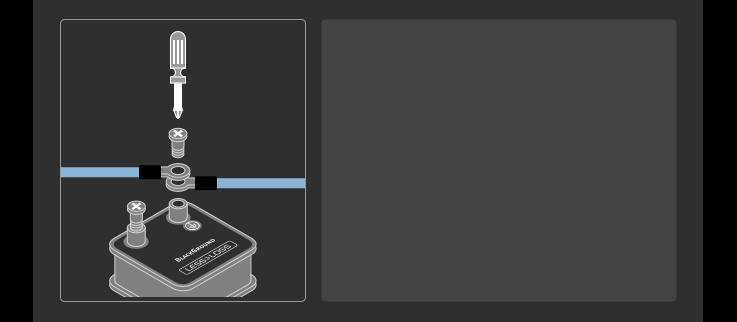
Protruding at the top are two contact posts. It is very easy to make contact. Use a Phillips screwdriver to attach a conductor end (for instance, an eyelet terminal). The bolts are already supplied with the unit. A small spade suitable for M3-size bolts can work just as well. LessLoss sells such custom-made C-MARC™ cables here
2--Specific use for loudspeaker audio signalsTap the two lines, signal positive and signal negative, and lead them separately to the terminals of two separate Blackground interfaces, which are not marked. The terminals marked with the ground symbol are to be electrically connected to the ground of the earth.For a stereo setup with two speakers, this equates to four units of Blackground interfaces. Use with the Firewall for Loudspeakers?You can most certainly use Blackground units in conjunction with the Firewall for Loudspeakers, to very good effect.If you are using the Firewall for Loudspeakers, note that it is of no consequence whether you tap the signals before or after the Firewall. Please note also that it doesn't matter whether you tap the signals at the speaker end or at the amplifier's output end. We provide C-MARC™ Grounding Cables for this purpose. Speaker-terminal-sized spades and banana terminations are available. For best results, the ‘large’-size C-MARC™ wire is recommended. Disregarding the possible use of Firewall for Loudspeakers, one channel's speaker connection looks like this: 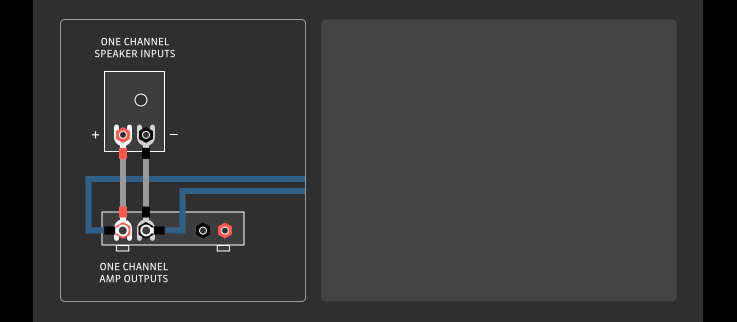
‘Tapping’ the instantaneous voltage of a speaker signal simply means electrically connecting to each of the signal's polarities. Shown here are two blue tapping wires which each connect to a separate speaker signal polarity. Since no current flows through them, they are only at real-time voltage parity and have no influence on impedance or load for the amp.
To connect the two Blackgrounds, proceed as follows, and please note that there is no alternative connection method:
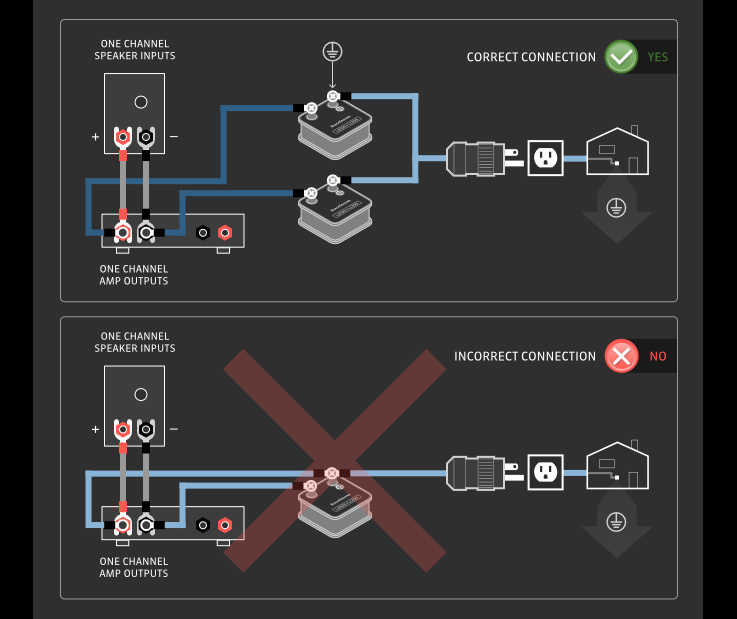
To scale up performance, two additional units per channel can be introduced in the following way. Again, please note that there is no alternative connection method.
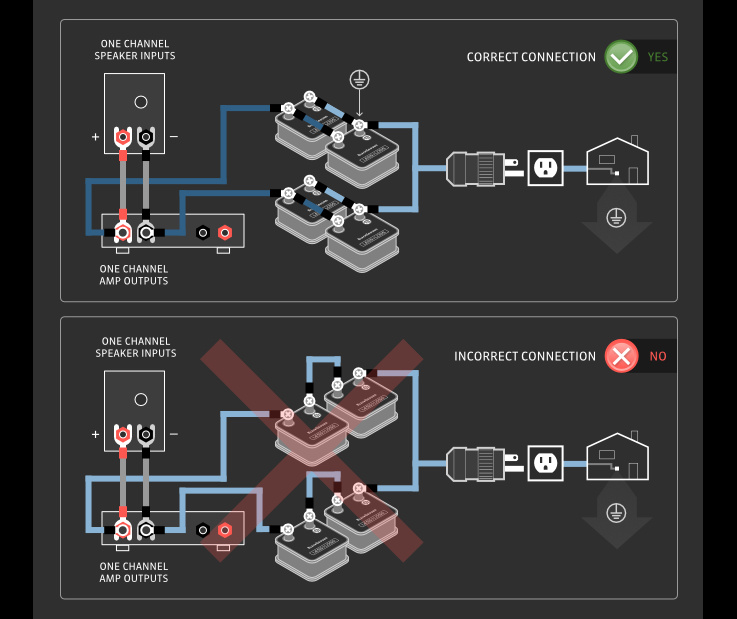
To be clear, Blackgrounds can be introduced anywhere along the line:
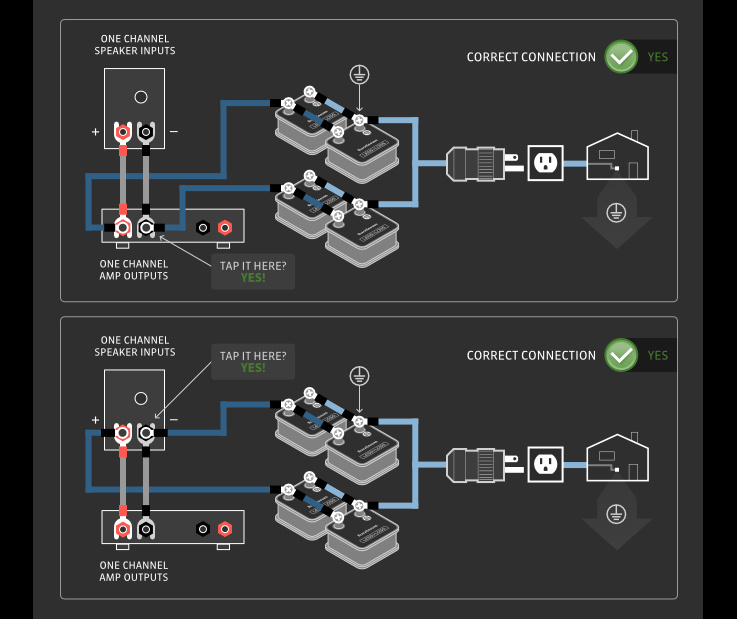
To continue to ramp up performance, simply introduce more in pairs (of twos) per audio channel:
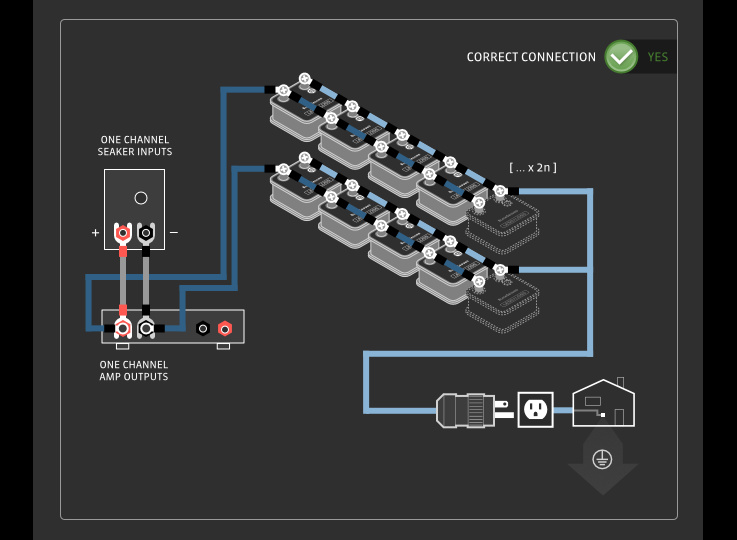
All the above is valid for only one channel. For a stereo pair, everything mentioned above will be multiplied by two. One set of two Blackgrounds will be for the Left channel's positive and negative polarities, and another set of two Blackgrounds will be for the Right channel's positive and negative polarities.
3--Specific use for unbalanced line level (RCA) audio signals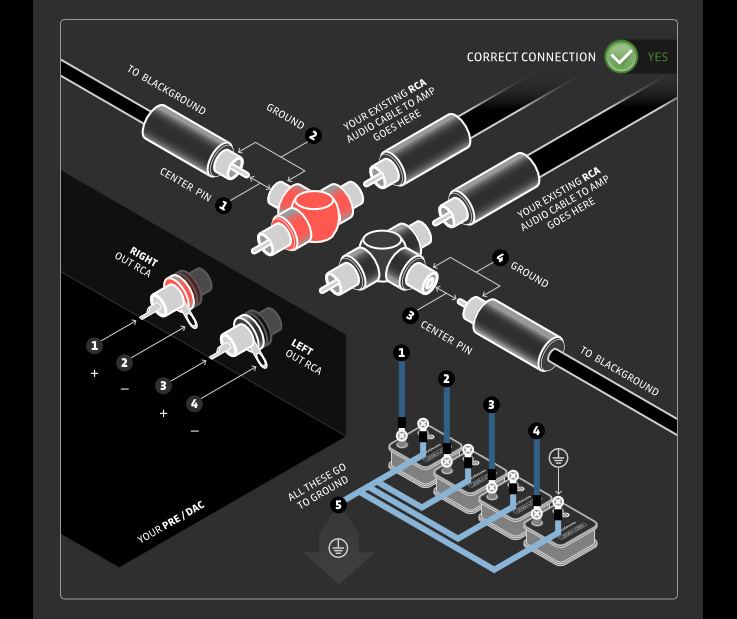
[Pictured above, two RCA splitters used to tap the RCA cable's signals into four Blackground units. One can tap the signals this way, or internal to either the signal sending equipment or the signal receiving equipment at the other end of the RCA cables adjoining the two pieces of equipment.]
Depicted below is how to connect Blackgrounds to a standard type of RCA unbalanced audio signal connection for one channel. 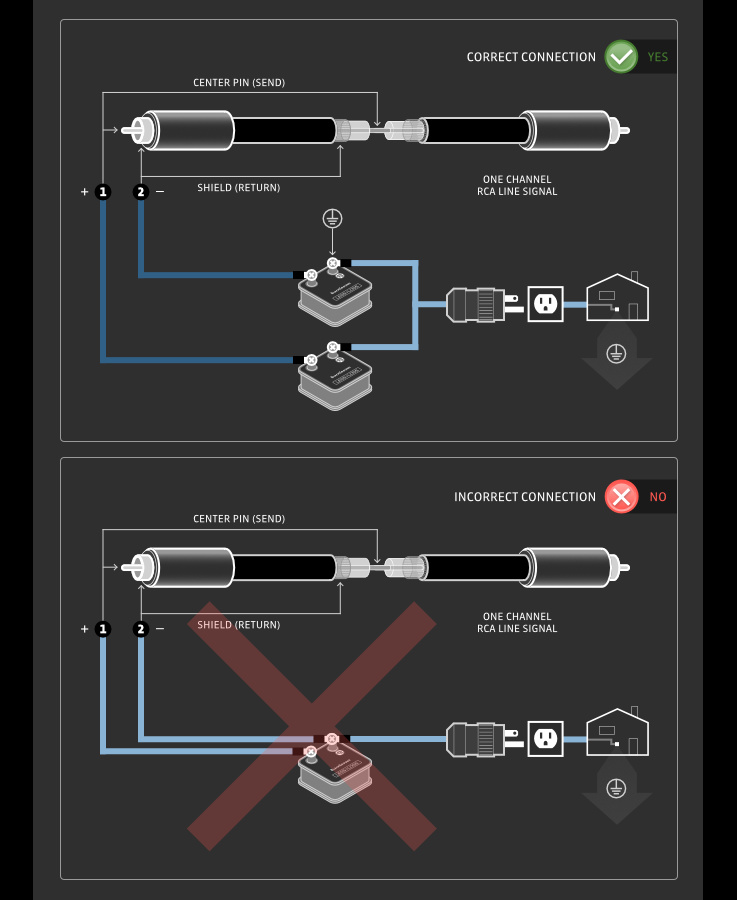
Tap the two lines, signal positive (send) and signal negative (return), and lead them separately to the terminals of two separate Blackground
For a stereo pair of two such unbalanced signals, this means that you will use four units of Blackground interfaces. Shown is the proper (and improper) way to carry out the connections. To scale up performance, an additional two Blackground units per audio channel can be used. Again, below you see how to connect them correctly to scale up performance. 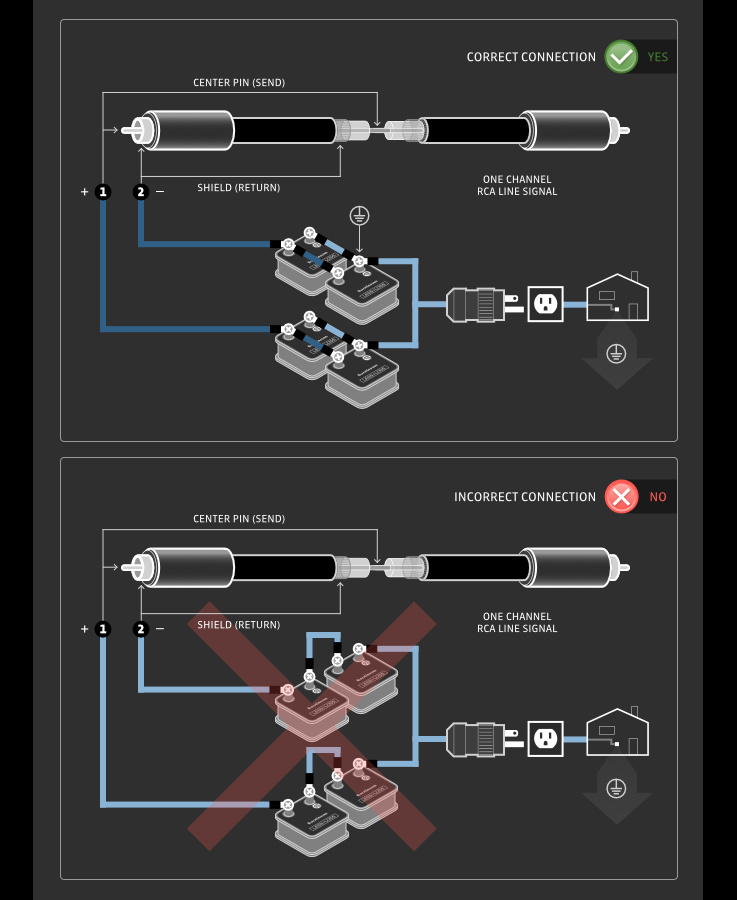
Note that it is of no consequence whether you tap the signals at the source end or the destination end. This can be done within the respective piece of audio equipment. We provide C-MARC™ Grounding Cables for this purpose. For best results, the ‘large’-size C-MARC™ wire is recommended.
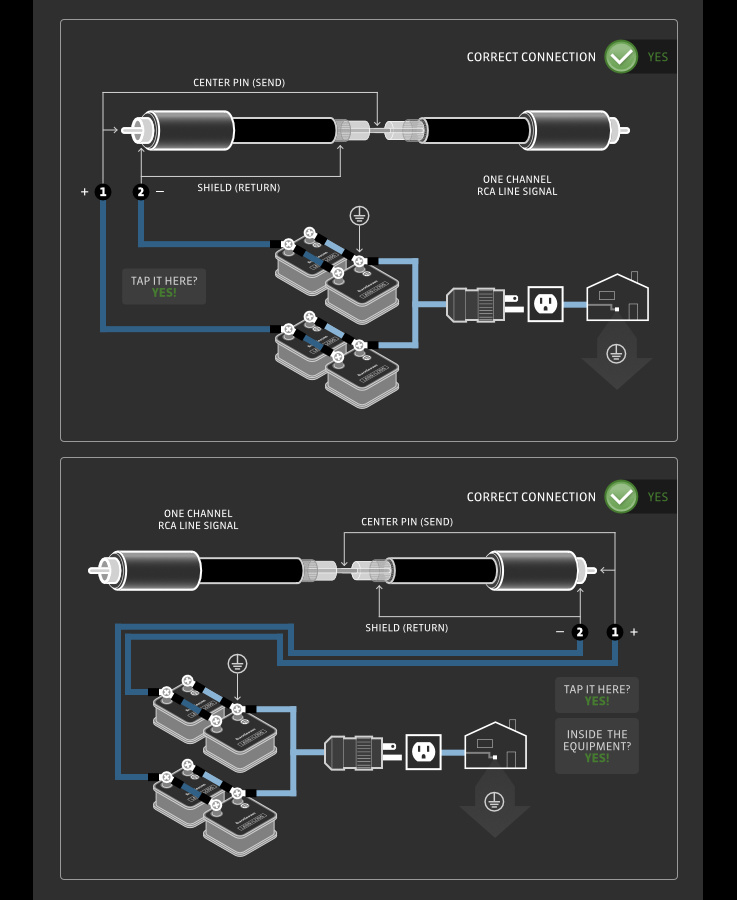
To continue to scale up performance, one can add a multiple of two Blackground devices to each audio channel pair of send/return lines.
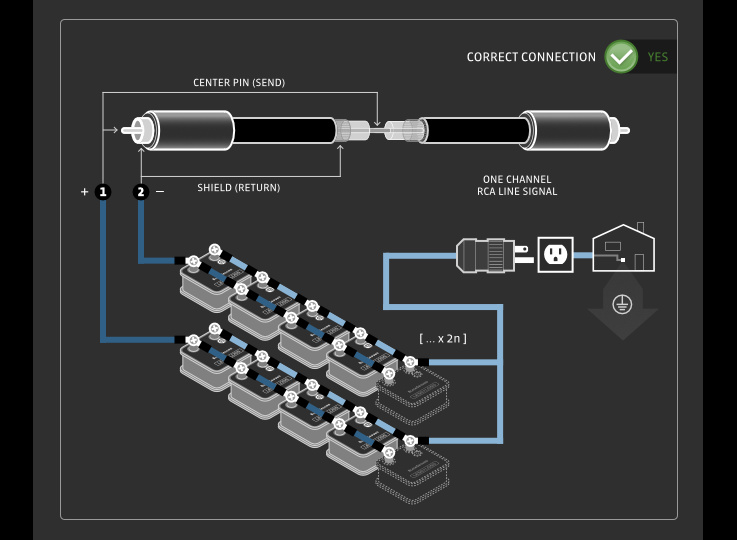 4--Specific use for balanced line level (XLR) signal connectionsPlease refer to the section above on RCA unbalanced signal connections. Substitute the signal positive (send) line for Pin 2 of the XLR connection, and the signal negative (shield or return) line for Pin 3 of the XLR connection.In the balanced line application, the Pin 1, (shield, ground), connection, of the line itself, is not tapped and not fed to the Blackground device. As with the unbalanced connection, here it is also of no consequence on which end of the line one installs the Blackground. 5--Specific use for AC Power voltagesPlease refer to the above section on loudspeaker signal connections. Substitute the signal positive (send, or red) line for the power's live line, and the signal negative (return, or black) line for the power's Neutral line.In the power line application, the ground connection of the power line itself is the very ground potential that the Blackground terminals with the ground symbol are to be connected to. As with the speaker signal connection, here it is also of no consequence on which end of the power line one installs the Blackground. This can be internal to the wall outlet of the building, internal to a power distributor to the system or internal to individual pieces of gear. Disclaimer There is no claim by LessLoss that cotton-clad C-MARC™ bulk wire and cable adhere to any widely recognized standard of voltage or current carrying capacity. This is because the raw cotton-clad wire is a specialty wire for the sole purpose of achieving ultra-high performance. Insurance companies most likely do not recognize this type of insulation in their specification demands, and we (LessLoss) do not make such claims either. There is no voltage rating for this cable and no certificate of conformity with widely accepted standards. For this reason, if you use it for any voltage larger than 24V, either make sure that in your application there is no possibility for the wires to touch, or add additional insulation like a braided protective sheath or a plastic tube of some sort of the thickness you yourself deem compatible with the specific application you intend to use it on. Never expose open conductive contacts of high voltage. This can cause shock or death through electrocution! When in doubt, consult a professional electrician. 6--Specific and unique use together with the LessLoss Blackbody v.2 ambient field conditionerThis is the only application in which the conductivity of the grounding line is lifted. This lifting is carried out internally to the Blackground device itself.Typically the Blackbody v.2 is connected to the building's ground as follows: 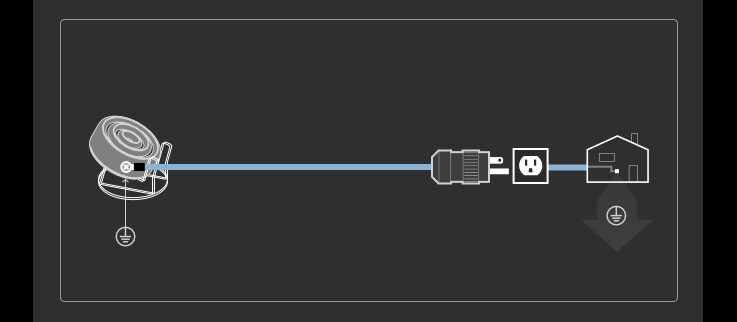
[Pictured above, using one Blackbody without the Blackground interface]
This can be a single Blackbody or a string of more than one Blackbody all grounded together in series. To properly integrate the Blackground device, connect as follows: 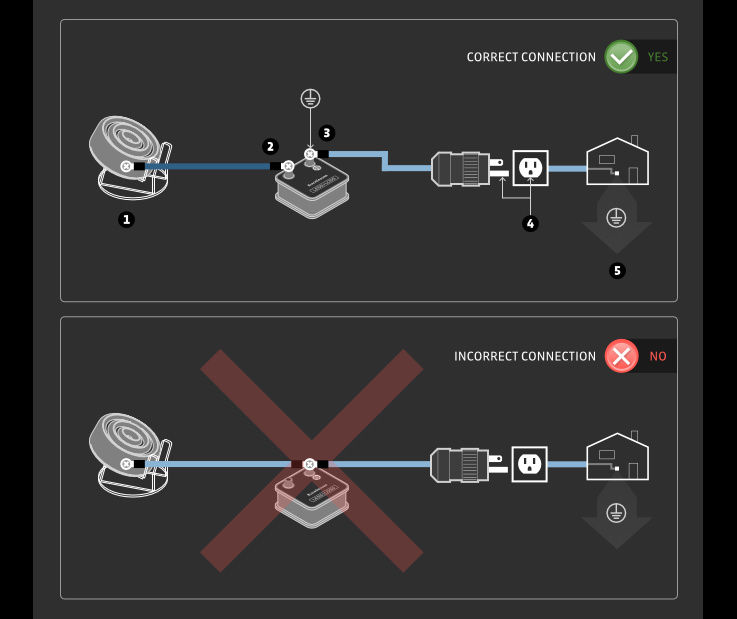
[Pictured above, Blackbody connected (1) to unmarked terminal (2) of Blackground unit. Other Blackground terminal, marked with the ‘ground’ symbol (3), connected to ground contact of wall outlet (4). House internal wiring feeds this contact to the physical earth (5).]
It is inconsequential as to what orientation the Blackground device is placed with regard to the Blackbody's position, angle, or vertical placement. The proper electrical connection as depicted is the only important factor here. To scale up performance, two Blackgrounds can be connected as follows: 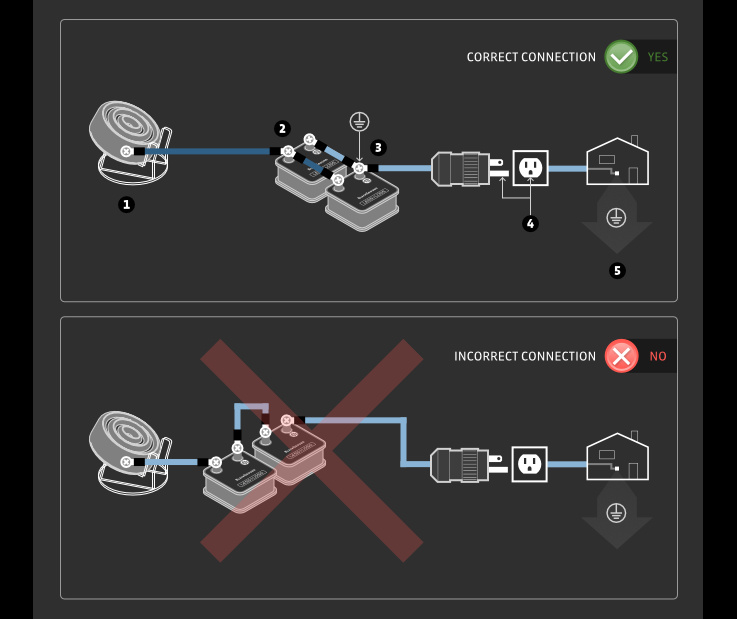
[Pictured above, Blackbody connected (1) to unmarked terminal (2) of first Blackground unit. The same unmarked terminal also connected to the unmarked terminal of the second Blackground unit. Other Blackground terminals, marked with the ‘ground’ symbol (3), both connected to ground contact of wall outlet (4). House internal wiring feeds this set of two contacts, both marked with ground symbols, to the physical earth (5).]
To scale up performance even more, we introduce another Blackground device in the following way: 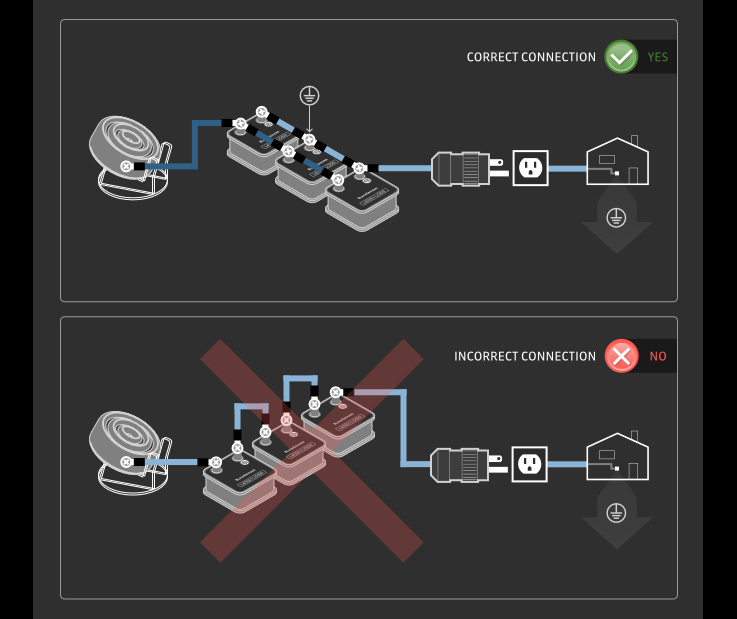
[Pictured above, Blackbody connected to three unmarked Blackground
If one has more than one Blackbody connected to more than one grounding pin on more than one power outlet, one can introduce a Blackground device on each of the final grounding lines which terminate in wall plugs. But the most efficient way to use multiple Blackbodies and multiple Blackground units is as follows: 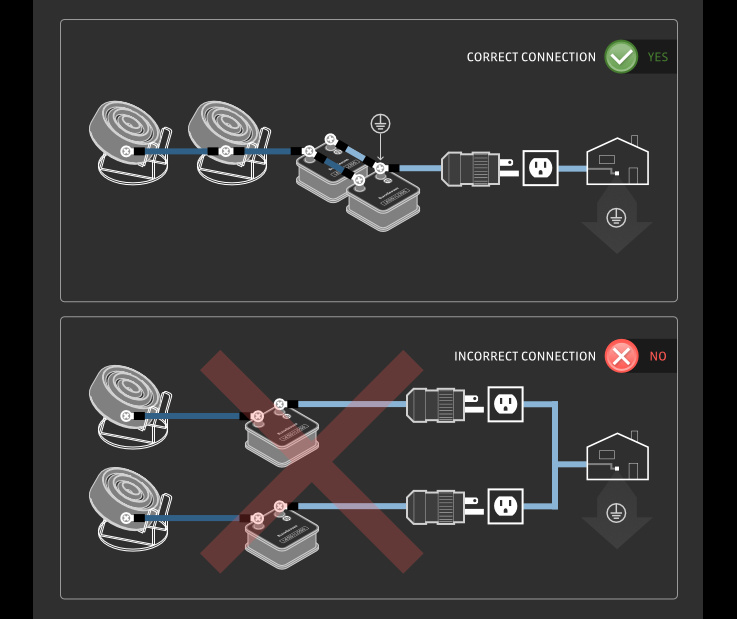
[Pictured above, the best recommended use of two Blackground units and two Blackbody units together.]
The two general rules for scaled up performance using multiple Blackbodies and -- Connect Blackbodies either in series, in parallel, or in combinations of series and parallel. This is of no consequence. -- Connect Blackground devices in parallel as shown. This is the most efficient way to use them, and the differences are audible. 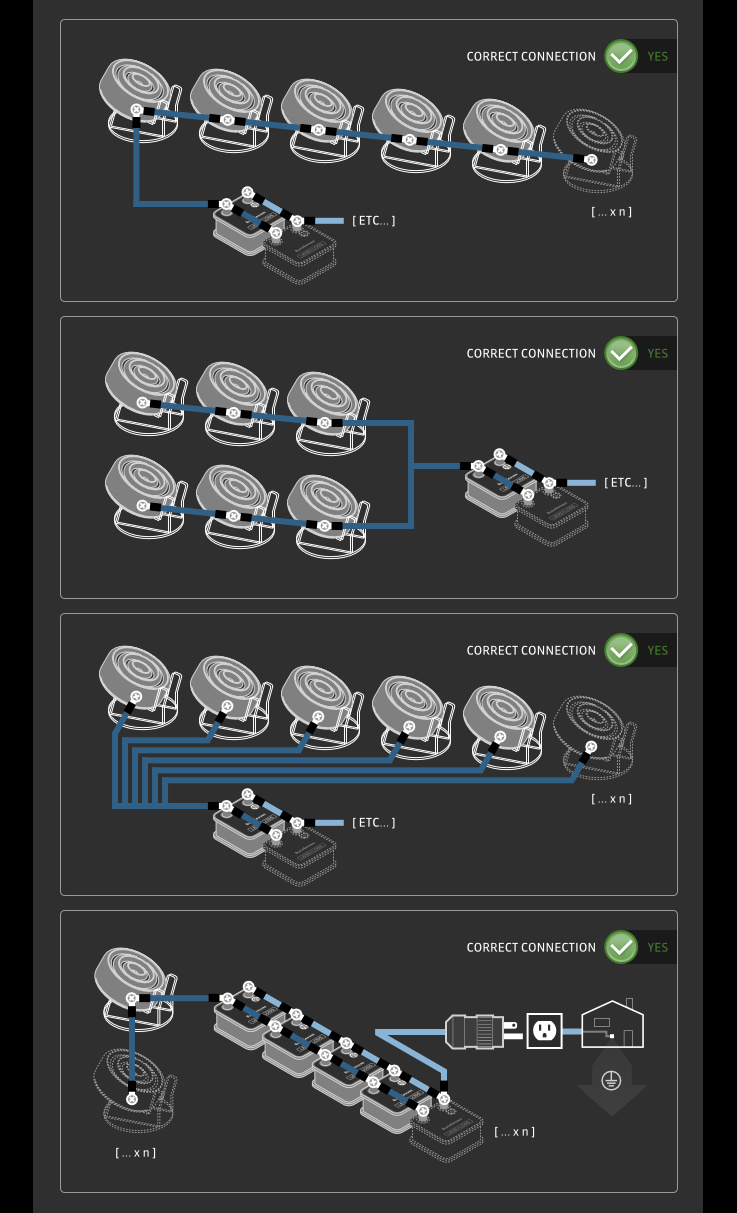 FAQPlease describe for me the aural effects I can expect when using the Blackbody v.2.In general, the Blackbody, when placed correctly, imparts a feeling of smoothness and calm, ‘flow’, if you will, and, also greater detail. This detail is not of the sort where pixelation is more pronounced, but of the sort where your listening ‘microscope’ has a new depth of zoom factor. Another analogy: Without the Blackbody, you look up at the night sky, but it is somewhat hazy with a washed-out background due to the light pollution in your town. With the Blackbody, you are transported to a rural environment far away from the metropolis. Looking up at the night sky, you now see so many more stars you were oblivious to before. What was perceived as a hazy background is now darker with more distinct stars from a far deeper cosmos. Can you tell me more about proper placement?
You don't need to worry about exactly where to place the Blackbodies. Far more influential is that you follow the correct angle and directional setup requirements to get the best results. Assuming you are in the Northern Hemisphere, your proper Blackbody orientation will be north. Think of it this way. Imagine you want to place a small mirror such that the sun sees its own reflection. From the vantage point of the sun, the earth is basically seen as a dot. Do you think it even matters to the energy radiating down on your system exactly where in the room you place that mirror? Not at all. But at what angle you place that mirror is going to be far more influential. The reflection angle is what counts here, not where that reflection exactly takes place. (Here I used the sun as an example, but of course anyone who has read the 13-page Blackbody v.2 discourse, and has watched the videos we point to there, knows that it is the earth's magnetic field influencing the directional stream of cosmic radiation that dictates the local angle and direction we need to use.)
You can put them on top of speakers, on shelves of your rack, or even on gear lids. But it really is less important where you place them. What is far more important to consider is the proper angle and direction. Even placing them on the floor works very well, provided that you pay attention to the proper angle and direction. You will choose your custom angle stand, provided free of charge, using the simple tool we prepared for you in our web shop. It's easy to do by simply locating your house on the interactive map provided. The tool then spits out the proper angle required for that location, and when you order, we will custom manufacture you the stands using that given angle. What grounding wire should I use? Any pointers here?
You can ground using any wire. You will probably see that the Blackbody v.2 will be somewhat less stable using solid core wire simply because solid core wire's stiffness can act like ‘coat hanger wire.’ You might inadvertently ‘yank’ the Blackbody, altering the direction at which you initially aimed it. You might want to tape your wire down to provide some tension release for the electrical connection to the Blackbody. This way, if you mess with some wires behind your system (who eventually doesn't?), you won't accidentally move the Blackbody. Our C-MARC™ wire is flexible and lightweight, but even so, this can be an issue in a finely set up situation. Especially if someone goes in to clean!
Are the effects measurable?
There was much work put into the development of this seemingly 'crazy' little device. Although the critical ear has guided us well, we remain very curious about possible measurement. We have already gathered some equipment to, in the near future, try to investigate and perhaps even measure(!) muon radiation patterns around the Blackbody. We'll see what becomes of this. Many recent advances in this field have made it possible for us to entertain this type of experimentation. Even just a few years ago, this type of thing would have been unthinkable.
What about burn-in? Does it work like an on/off switch, or is it more of a 'ramp-in' experience we know from cable swaps?
As mentioned above, the Blackbody focusses the sound, gives better clarity, and reveals much new detail, but does so not merely as a simple ‘on/off' switch when you introduce it or take it out. It goes more like this: Put it in, get ~80% of the result right away. Wait a while (maybe half a day), and you will gradually get the remaining ~20% performance. Now, take it out, lose ~80% of the performance, but retain about 20% for a while (this is kind of spooky at first - why should this happen?). After some time, the remaining ~20% effect fades out fully, and one is left again with the usual haze over the sound.
This has undoubtedly a serious explanation. Let us indulge in some guesswork here. Think of the daily heat cycle of the sun's radiation and the ground. During the day, the asphalt heats up, but when the sun sets, you can still feel the warmth radiating from the asphalt for a long while. Early in the morning, before sunrise, it is coldest. It heats up pretty slowly during the day, so that only after several hours of direct sunlight does the heat radiation from the sun add up and the asphalt reaches its hottest. Because of this cumulative effect, the surface temperature of asphalt only reaches its highest long after the sun has passed that day's zenith. On a hot summer day, this can actually be just prior to sunset. At dusk, and quite a long time afterwards, you can still feel that day's heat radiating off the asphalt, even when there is little, or no light left from the setting sun. Move to a grassy area and suddenly you feel how much faster the bare earth and vegetation get cold. The same thing applies in the morning, only in reverse. As the sun rises, the asphalt is still cold and only heats up gradually. In terms of the radiating heat, it definitely is not its hottest when the sun is directly overhead. This analogy might apply, on a lower level, to cosmic radiation and the gear's interaction with it. Imparted muon (or other high-energy particle) radiation onto gear may, on some level, elicit a delayed effect response like how asphalt does regarding sunlight every day and evening. This might explain some aspect of the delayed response in sonic performance mentioned above. This is our best analogous guess as to why this ramp-in and ramp-out effect displays itself when experiencing the use of the Blackbody in a system. Does it matter how I run my grounding cables?
It doesn't matter how you run the grounding cables from the Blackbodies. Let's say you have a string of seven inter-grounded Blackbodies and have one last grounding cable make contact with the building's ground. In an adjacent room you have some other equipment, and you have over there three additional Blackbodies with their own ground string of connections, again with one last cable making contact with building's ground. If you run the grounds together through a hole in the wall and ground them all into a single outlet, the results will be the same. Likewise, if you had all ten Blackbodies, each separately grounded to ten separate wall outlets, the results would be the same.
How do the Firewall 640x and Firewall for Loudspeakers compare to the new Blackground device?
One should consider the Firewall 640x (and Firewall for Loudspeakers) as current conditioners since the currents in question in fact flow right through the conditioner. The new Blackground interface, however, is a voltage conditioner since no currents flow through the device. Instead, with the Blackground, we tap the existing voltage at each signal conductor (regardless of whether it is AC or DC, positive (send) or negative (return), or Blackbody ground). This real-time voltage, regardless of what it is, is routed to the Blackground device on one terminal. The other terminal marked with the ground symbol is connected to the ground voltage of the building; this is really the ground potential of the earth itself, because the building's ground is a physical conductive stake in the ground.
Why? What's the point? The Oh My God particle.
High-energy particles traverse space at near the speed of light. The highest energy subatomic particle observed scientifically (so far) was named the OMG particle ‘...equivalent to a 142-gram (5oz) baseball travelling at about 28 m/s (100 km/h; 63 mph).’
We are surrounded by layers of protection. The first of these is the sun's magnetic field. The field does this shielding (actually, bending) for the highest, most deadly, energetic cosmic particles. The earth's magnetic field is yet another layer of protection. The earth's magnetic field bends remaining ionic radiation towards the poles. But some still gets through, and at this point we already know its statistically most likely angle and direction, given our location on the crust of the earth. Muons and other subatomic particles constantly travel directly through buildings, ground, even our own bodies. This radiation is everywhere. If we cannot adequately shield ourselves from this inevitable cosmic influence, and we cannot dig an audiophile protection cave several kilometres underground in granite, we can at least seek ways to, in a way, ‘raise’ the desirable features of the earth's protection and implement them in an elegant, concerted way, directly at the signal's existing potential level instead of at the EM surroundings level, which anyway for cosmic particles is simply inconsequential. You can shield all you want using traditional means, but to no avail. Lightning rods operate by raising the ground potential up to their ionising tip, making it far more likely for lightning to strike them rather than nearby rooftops or other exposed raised structures such as power stations. With the Blackbody and Blackground we do something similar. The following analogy with baseball will pitch (ha!) an explanation. 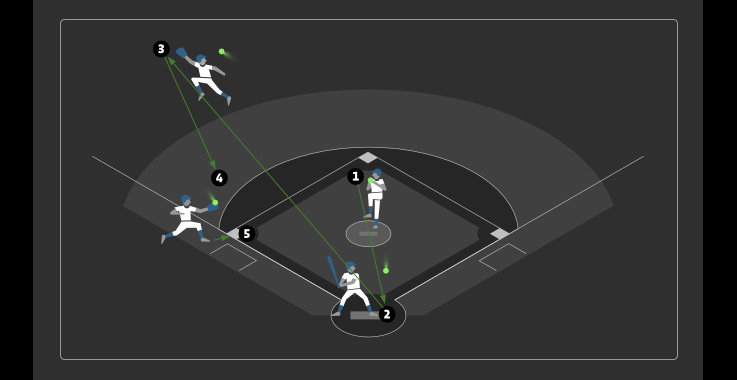
Baseball analogy: The baseball is the cosmic charged particle. The pitcher is the source of the cosmic particle (supernova or whatever) [1.] and the batter is the cosmos which flings the particle in question out towards the earth [2.]. The catcher out in the field is the Blackbody, aimed at the proper angle and direction, ready to catch. [3.] Through a grounding wire, he throws the impulse as quickly as he can to the baseman. The baseman represents the Blackground signal-ground interface. [4.] He catches the throw with his glove and, with his shoe, stands on the base (ground potential) without physically tagging the runner (no electrical contact is made) [5.]. This represents the score's neutralisation. The particle is dealt with. Team Cosmic, you're out! The cheer from the stands of our team, Team Sonic, can be heard for miles.
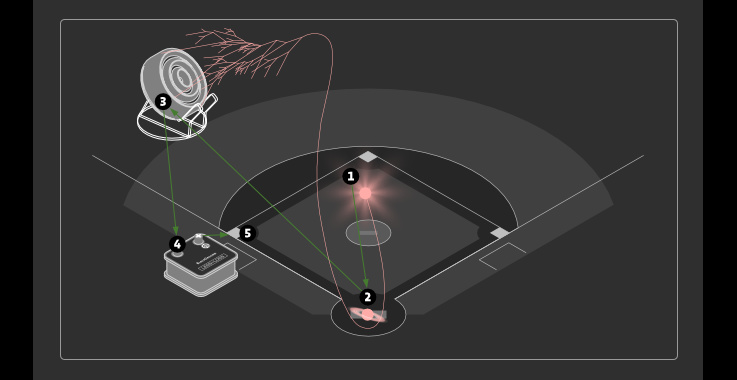 There exist many so-called 'grounding boxes' in the market today. Is BlackGround one of these?Absolutely NOT!... still, in a way, yes. These solutions which offer many ground connections and in their own ways condition the ground plane of the entire system, tap ground potential in different places throughout the system. But according to our understanding, they only go a part of the way, and they are belated in their treatment even at that. These devices are purported to try to capture ‘EMI/RFI’ small signals traveling everywhere in our audio systems and transform them into heat. However, this is not the precise concept behind the Blackground technology. With Blackground technology, LessLoss takes a different approach. If your solution is even worrying about ‘EMI/RFI’ existing throughout the system, it is already too late. These signals are AC signals, and to fluctuate, they need a send path and a return path. There are always going to be such undesirable oscillations in high frequencies throughout a system and every electronics engineer works hard (or should work hard) to eliminate as much of these as possible. However, reliably measuring these at high frequencies is mostly a shot in the dark, as the lack of strict impedance matched lines at these high frequencies makes it almost impossible. Then there is also the widespread disregard that at these high frequencies this type of noise is even a threat. You really must think of Blackground as addressing a far more pervasive and universal issue, and that is the issue of cosmic ionic particle precipitation. Think of this as a form of constant rain on our audio experience. It can be a light drizzle, or it can be a thunderstorm. We are not in control of it, but we can use what we know about it to our advantage. It will always be there no matter what we do, but we can guide it, using Blackgrounds like lightning rods, to where it will not cause the subtle EMI/RFI loops mentioned above. Those AC currents are on both the ground plane (and associated inter-connecting grounding wires) as well as on the signal lines. Every conductor interacts with its surroundings. But even the term 'surroundings' implies differentiating between signal and the EM field. This is a fallacy. The signal is made up of the very subatomic interactions that permeate all matter. Otherwise, we would have liquid copper flowing through tubes of nonconductive material. If we deal with interference only on the ground connections, we are only capturing half of the issue. There are plenty of signal/ground interfaces within a system already. Basically, any resistor is such an interface. Any load is as well. This is the real ‘heat’ mentioned above in the paragraph about traditional ground boxes. This load is in fact the burning of a signal to some end. For us audiophiles, the primary end we are most familiar with is the physical driving of the loudspeaker in the form of vibrations. Heat is the loss of any resistor, coil, or load. Perhaps some images will serve us well here. Consider the images below as idealised snapshots of cosmic precipitatory subatomic particle interaction. What you need to realise is that we are not speaking of billiard balls, and we are certainly not speaking about one thing happening after another in a simple string of events on a simple one-dimensional timeline. When dealing with high-energy subatomic particle precipitation, we cannot lose sight of how exotic the concepts here are. For instance, the OMG particle mentioned a few questions above was travelling very near to the speed of light. “At this speed, if a photon were travelling alongside the particle, it would take over 215,000 years for the photon to gain a 1 cm lead, as seen from the earth's reference frame.” We are not equipped here to go into a full-blown scientific discussion of the actual theory involved but suffice it to say that there are relativistic concepts at play here which make the baseball analogy above somewhat misleading. Just think about the following images as not necessarily happening on a single timeline, with some interactions having a jump start in front of others and recall the famous post-graduate course question as well which asks what the length of a single photon is, given certain conditions in a room. The correct answer is about one meter(!) in length. So, for your imaging you can forget raindrops and billiard balls and all manner of simple colliding we used to make our point. This stuff is much more exotic. And let us not forget that even our signals are made of subatomic particles. 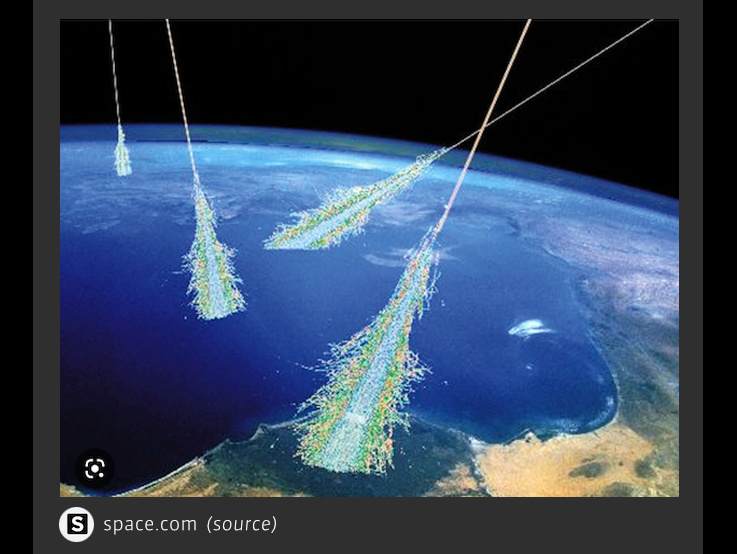 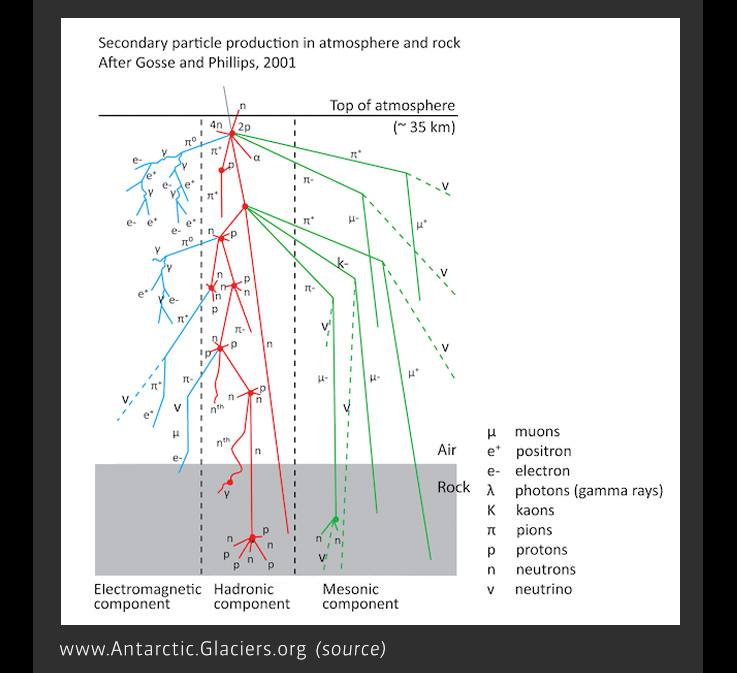 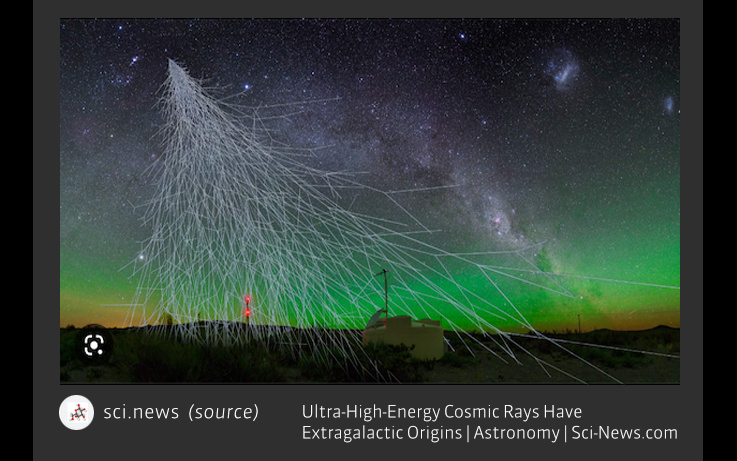 How else can you simply explain the core functionality of the BlackGround?
Let’s start with how lightning rods work. A lightning rod is a conductive extension of the ground potential up into the sky. At the top, it is pointy, and this means that a small corona discharge occurs at this place. Why? There is a concept called atmospheric voltage. The farther up you go from the surface of the earth, the higher the atmospheric voltage. It goes up at about 100V per meter. Once you get up to the ionosphere, you are dealing with conductive plasma. When you extend the ground voltage up to higher voltage surroundings, you get a large voltage potential (difference) at the tip of the lightning rod. When a high-voltage lightning discharge occurs, it seeks ground potential. Since the ground potential is ‘piercing’ the sky at the tip of the lightning rod, the lightning will naturally choose that path as that’s the path of least resistance. You can watch this video:
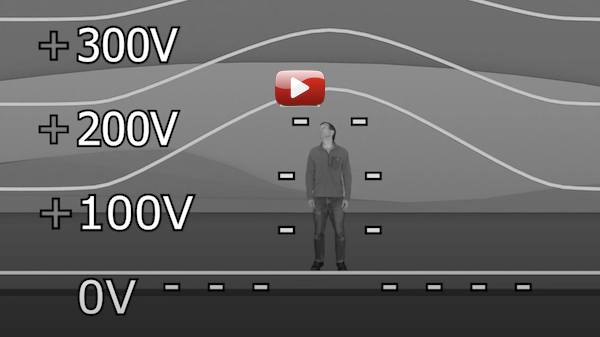
Imagine a super slow-motion film during which the various voltages in a sound system fluctuate. This is like the ions in the air from the video. They are not at ground potential. They fluctuate in real time, whereas the atmospheric voltage is more or less static. In addition, there are sources of noise that come from the continuous cosmic ionic particle bombardment, what we described as “rain” on our audio system. Ideally, we want this bombardment to find an electrical path which will not interfere with our various signals. Enter *Blackground*, our innovative solution, by which we have in effect generated a continuous lower impedance path for the cosmic ionic particle 'rain' to follow. And how? By pairing real-time voltages in the sound system with the ground potential. Any electrical discharge will always choose the lowest impedance path. It represents a lower impedance path because the Blackground is always at the same voltage that the signals are at. In this sense, we keep the resistance path between noisy atmospheric voltages and the ground at the lowest we can possibly muster. Not a small feat! Thus, the noise from cosmic radiation chooses this path and is dealt with even before it interferes with the prized signals we want to protect from these interactions, and our music can flow more freely. In fact, because the path presented is following the signal voltages in real time, it can be said that the signals themselves now become the conductors for the foreign noise instead of succumbing to intermodulation by it. The reason why more and more Blackgrounds (and Blackbodies) are effective is that with every additional unit, we are lowering and lowering this impedance path, so the results in terms of sonic purity are better and better as statistically less and less intermodulation occurs. |
- Products
- Power Cables
-
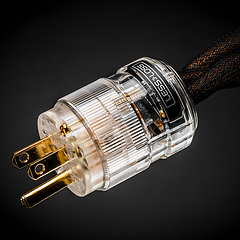 C-MARC™ Prime
The must have foundation for any sound system today.
From
$
486
C-MARC™ Prime
The must have foundation for any sound system today.
From
$
486
-
 C-MARC™ Classic
The unique super-cable power cord everyone's talking about.
From
$
1148
C-MARC™ Classic
The unique super-cable power cord everyone's talking about.
From
$
1148
-
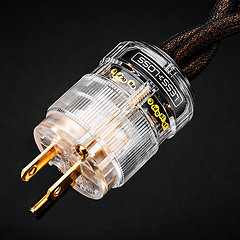 C-MARC™ Classic Entropic Process
The peerless, advanced Classic masterpiece.
From
$
1934
C-MARC™ Classic Entropic Process
The peerless, advanced Classic masterpiece.
From
$
1934
-
 C-MARC™ Stellar Entropic Process
The crown jewel for highest performance power connection.
From
$
2450
C-MARC™ Stellar Entropic Process
The crown jewel for highest performance power connection.
From
$
2450
-
- Loudspeaker Cables
- Interconnect Cables
-
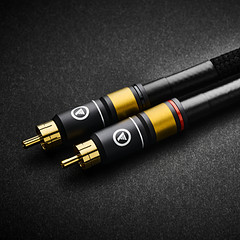 RCA C-MARC™
Cotton-clad true Litz • Whopping 2.3mm2 polarities
From
$
850
RCA C-MARC™
Cotton-clad true Litz • Whopping 2.3mm2 polarities
From
$
850
-
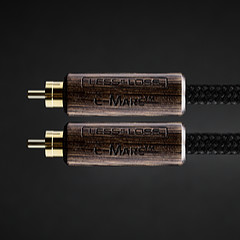 RCA C-MARC™ Entropic Process
Our finest RCA cable • Polished Wenge barrels
From
$
1428
RCA C-MARC™ Entropic Process
Our finest RCA cable • Polished Wenge barrels
From
$
1428
-
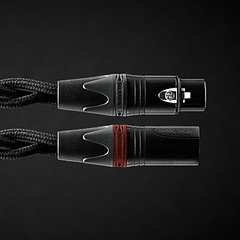 XLR C-MARC™
A hand-braided cotton-clad unique Litz construction
From
$
950
XLR C-MARC™
A hand-braided cotton-clad unique Litz construction
From
$
950
-
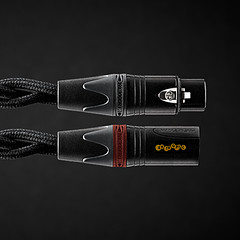 XLR C-MARC™ Entropic Process
Stratospheric performance for the audio connoisseur
From
$
1615
XLR C-MARC™ Entropic Process
Stratospheric performance for the audio connoisseur
From
$
1615
-
- Digital Cables
-
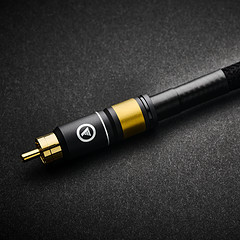 RCA Digital C-MARC™
Cotton-clad unique Litz design • Made only by LessLoss
From
$
510
RCA Digital C-MARC™
Cotton-clad unique Litz design • Made only by LessLoss
From
$
510
-
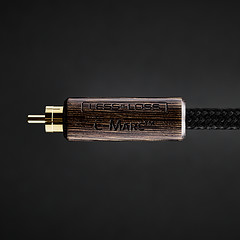 RCA Digital C-MARC™ Entropic Process
Possibly the most subtle digital cable on the planet
From
$
858
RCA Digital C-MARC™ Entropic Process
Possibly the most subtle digital cable on the planet
From
$
858
-
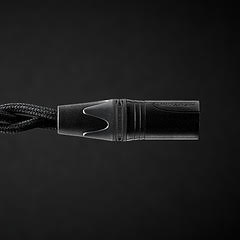 XLR Digital C-MARC™
Featuring a whopping 3 x 2.3mm2 Litz construction
From
$
570
XLR Digital C-MARC™
Featuring a whopping 3 x 2.3mm2 Litz construction
From
$
570
-
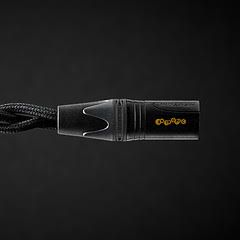 XLR Digital C-MARC™ Entropic Process
Stratospheric performance for the audio connoisseur
From
$
969
XLR Digital C-MARC™ Entropic Process
Stratospheric performance for the audio connoisseur
From
$
969
-
- Grounding Cables
- Bulk Wire and Cable
- Signal Conditioners
-
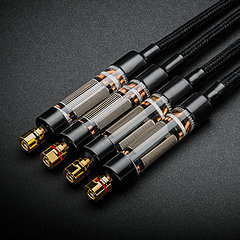 Firewall for Loudspeakers
Firewall for Loudspeakers
C-MARC™ Plug-and-Play Speaker signal conditioning like you've never imagined From $ 1656 -
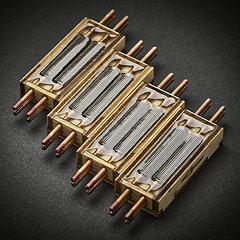 Firewall for Loudspeakers
Firewall for Loudspeakers
DIY version for Self-Installation For the Do-It-Yourself project enthusiast • Solder yourself From $ 800 -
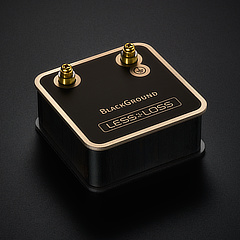 BlackGround DIY
Voltage-ground interface for a variety of applications
From
$
446
BlackGround DIY
Voltage-ground interface for a variety of applications
From
$
446
-
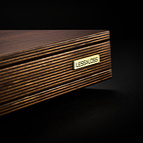 BlackGround 8x/10x Speaker Base
Plug-and-play loudspeaker signal conditioner
From
$
3096
BlackGround 8x/10x Speaker Base
Plug-and-play loudspeaker signal conditioner
From
$
3096
-
- Power Conditioners
-
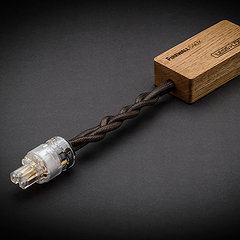 Firewall 640x
Plug-and-play solution for any powered gear
Firewall 640x
Plug-and-play solution for any powered gear
C-MARC™ Entropic Process and standard lead versions From $ 654 -
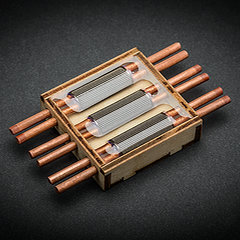 Firewall 640x DIY for Self-Installation
Self-solder and save!
From
$
320
Firewall 640x DIY for Self-Installation
Self-solder and save!
From
$
320
-
 BlackGround DIY
Voltage-ground interface for a variety of applications
From
$
446
BlackGround DIY
Voltage-ground interface for a variety of applications
From
$
446
-
 BlackGround 6x/10x Power Base
Plug-and-play power conditioner
From
$
2350
BlackGround 6x/10x Power Base
Plug-and-play power conditioner
From
$
2350
-
- Power Distributors
- Equipment Feet
- Field Conditioner
- DACs
- Power Cables
- Reviews
- This is definitely the cable to go for. It will almost literally blow your mind. – March 2012, Puresound Magazine
-
I was intrigued by the unanimously positive reviews garnered by these products ...
– by user Raymond Eye
Leaves you speechless
Sensational cables
BEST purchase I've made
Top notch performance
It's a steal
Musical... liquid... 3D
It's not subtle
More than an upgrade
Best I've heard so far
Stellar service
Sounds like a new system
Much more lifelike
Emotional flow
Overwhelming results
More dimensional
Sound is transformative
We were all astounded
Transformed my listening
Sounds so cohesive
Emotionally engaging
- Where to Start
- Free Newsletter
- Newsletter Archive
- B-Stock Alerts
- Shopping Tools
-
Shipping
- Free Shipping Learn about our international shipping policy
-
Return Options
Our satisfaction guarantee
and return policy -
Customs / Tax
UPS expedites local
customs clearance
-
Transaction
- Conditions of Sale Agreement for a smooth business transaction
- Privacy Policy We pledge to keep your information private
-
Terms of Use
Business policies
and agreements
-
Account
-
- Contact Us
-
Meet the Designers
-
- Care to share of your personal experience with our products? We'd be happy to post it!
- Want to learn more about our activities? Our Newsletter is both free and spam-free.
hi-res photos, brochures
logos, press releases, and
print-friendly PDF downloads. -
Contact Us
Connect with Us
-
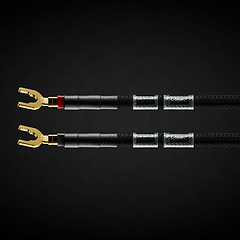
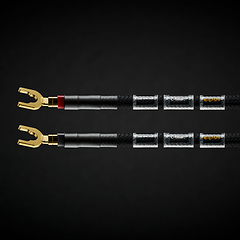
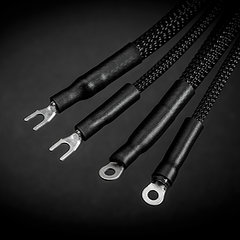
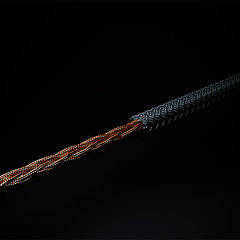
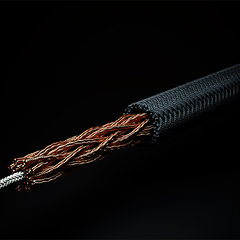
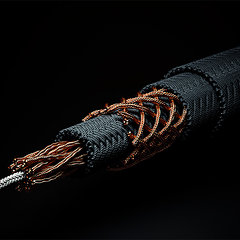
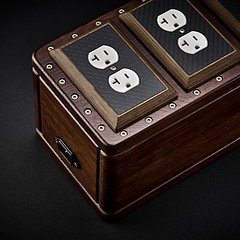
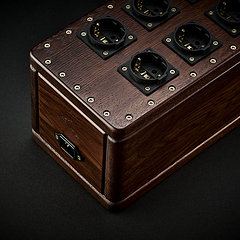

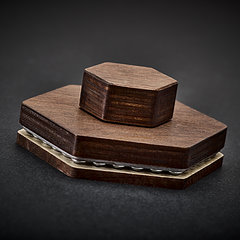
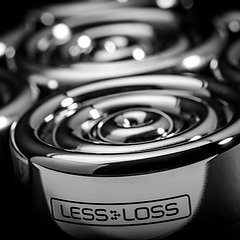
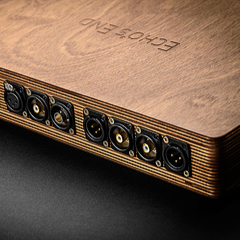
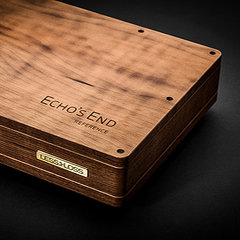
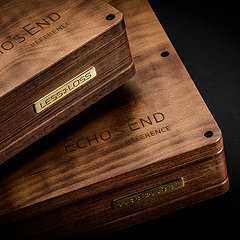
 Beware of Fakes
Beware of Fakes














